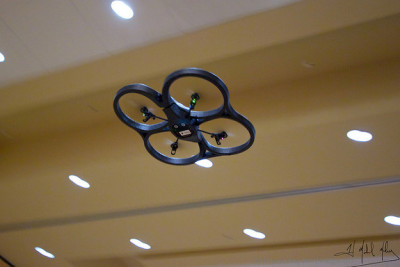Earlier this week, the FAA has finally submitted the outline for the proposed regulations for small drone operation and use. But after the submission of the long-awaited proposal, companies like Amazon are far less than pleased. Under these new regulations, small Unmanned Aircraft System (UAS) cannot be operated out of the line of sight of the operator, making proposed deliveries from companies like Amazon impossible.
The 200 page regulation draft was published on Sunday, and the President issued a complementary Presidential Memorandum to go along with it. The proposed rules are not set in stone yet, and the FAA will be accepting comments at regulations.gov for the next 60 days or so.
Here’s a brief overview of the important points of the proposed rules:
Operational Regulations
The regulation states that the drone cannot operate out of the line of sight of the operator or visual observer, and the operator must be able to see the device without visual aid or technology (exempting corrective lenses). Drones can only operate within daylight hours and only when the minimum weather visibility from the control station is at least three miles.
Small drones, which are classified as drones that weigh less than 55 lbs, cannot fly over parties not involved in the direct control of the device, which pretty well squashes a lot of photography uses without careful planning. However, there is a MicroUAS proposal (for drones under 4.4 lbs) that would allow micro-sized drones to fly over people “provided the operator certifies he or she has the requisite aeronautical knowledge to perform the operation.”
Drones are, obviously, not allowed in restricted airspace or in airspace classified B, C, D, or E without permission. The lowest airspace, G, is uncontrolled and drones are allowed to fly there without any issue. Class G airspace is basically the lowest to the ground airspace, and is defined as airspace that is not controlled by other classifications. Read the FAA Definition of Class G Airspace for more information.
The regulations mention that all small UAS must have ‘aircraft markings’ similar to those required to be displayed on other aircraft. If the UAS is a micro and too small to display markings in standard size, then it must be displayed ‘in the largest practicable manner.’ I’m not really sure exactly what markings are required, as I believe it varies by country and by what the craft is designed to be used for. Check with the FAA for more information.
And last, but not least, drones must yield the right-of-way to all other aircraft, manned or unmanned and must always be the first one to swerve out of the way of other aerial vehicles. Drones are only allowed to fly a maximum of 100 mph and no higher than 500 feet.
Operator Certification and Responsibility
There are several certification requirements and regulations on operators as well, the first being that an operator cannot operate more than one UAS at a time, and careless and reckless operations are, obviously, not allowed. I’m not really sure why they felt the need to spell that out, but I suppose better safe than sorry.
Undoubtedly a response to the drone crashing into the White House Lawn last month, the regulations also state that no person may operate a drone “if he or she knows or has any reason to know of any physical or mental condition that would interfere with the safe operation of a small UAS…” so basically, no drunk droning. Especially not on the White House Lawn (which I believe is restricted airspace anyway).
In order to legally operate a UAS, all pilots (referred to as ‘operators’) must:
- Pass an aeronautical knowledge test at an FAA-approved knowledge testing center
- Be vetted by the Transportation Security Administration
- Obtain an unmanned aircraft operator certificate with a small UAS rating. (This certificate never expires)
- Pass a recurrent aeronautical knowledge test every 24 months
- Be at least 17 years old
- Make the UAS available for FAA inspection upon request, along with any required documentation
- Report all accidents which result in injury or property damage to the FAA within 10 days
- Conduct a preflight inspection prior to every flight which include specific aircraft and control station systems checks.
At this time, it doesn’t look like the FAA is going to require any kind of official airworthiness certification for drones, which is probably for the best as I don’t see how they could really keep up with that. The regulations do state that operators are responsible for preflight inspection (as listed above), basically making it the operator’s responsibility to ensure the craft is functioning properly.
Overall, I’m honestly pretty surprised that the FAA managed to get the rules out so soon, as the last I read, the FAA was saying not to expect anything from them for all of this year. Presumably, someone put pressure on the FAA, but I’m certainly not going to complain, as we have been waiting for rules since at least last year.
Drones and FAA Accountability
In the Presidential Memorandum that was issued shortly after the regulations were published, President Barack Obama outlines the acceptable of UAS regarding public safety and privacy and suggests rules to ensure that drones do not invade the privacy of citizens. Most of it is legal jargon and doesn’t really say all that much other than that using drones to invade privacy is illegal–as it should be.
Most of the memorandum is actually aimed at FAA accountability and transparency. The main notable thing is that the memorandum requires that the FAA review their drone usage rules a minimum of every three years to ensure that the laws stay current with the pace of technology and innovation.
If you want to read the full legalese of the memorandum, you can find it here.


